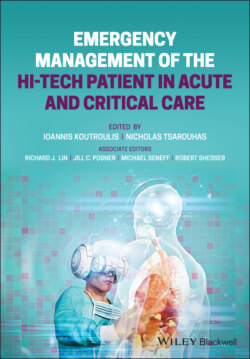Читать книгу Emergency Management of the Hi-Tech Patient in Acute and Critical Care - Группа авторов - Страница 50
Late Stomal Complications
ОглавлениеParastomal hernias are more common with colostomies and have a reported incidence of up to 48%. Other risk factors include obesity, poor abdominal muscle tone, chronic cough, and placement of the stoma outside the rectus muscle. Parasternal hernias are usually asymptomatic, but, as the size increases, it can impede adherence of the ostomy pouch. Strangulation and obstruction are rare but serious complications, and it is important for the ED physician to be comfortable determining if a hernia is incarcerated. Any hernia that cannot be manually reduced, is extremely painful, or appears dusky requires urgent surgical consultation. Symptoms of obstruction, including vomiting, abdominal distention, and decreased ostomy output, require two‐view abdominal x‐rays. Elective surgical revision is performed for definitive management of parastomal hernias; however, there is a high recurrence rate. Nonoperative management includes abdominal support belts and education regarding avoidance of heavy lifting or other maneuvers that may increase intra‐abdominal pressure.
Figure 2.1 Stomal prolapse.
(Source: Photos courtesy Judith Stellar)
Stomal prolapse occurs when a proximal segment of the bowel intussuscepts and protrudes through the stoma (Figure 2.1). The incidence of prolapse is 7–26% and is more common with loop transverse colostomy and end descending colostomies. The majority of prolapses are not of clinical significance but can be distressing to patients and make appliance placement difficult. Small, uncomplicated prolapses can be manually reduced by the ED physician at the bedside. Sedation may be necessary depending on the size of the prolapse and the discomfort of the patient. Before reduction is attempted, the edema of the prolapse may be reduced by applying cool compresses or osmotic agents such as honey or sugar for approximately 30 minutes. The prolapse is then lubricated with a water‐soluble lubricant, and with gloved hands, circumferential pressure is applied on the prolapsed mucosa. Placing a finger in the center of the prolapse may help guide the reversal process. After the prolapse is reduced, an abdominal binder should be placed, and the patient should be instructed to avoid lifting or other activities that increase intra‐abdominal pressure and should follow up with their ostomy team as an outpatient. Complicated prolapses, prolapses causing ischemic changes or severe mucosal irritation and bleeding, and those that are unable to be reduced by the ED physician usually require surgery.
Stomal stenosis is a less common complication of ostomies with an incidence of 2–15% and more often seen in patients with Crohn's disease. Symptoms of stomal stenosis include noisy stoma when flatus is passed, reduced output, diarrhea, or cramping abdominal pain followed by explosive output. Severe stenosis may present with obstruction. The ED physician may assess for mild stenosis by digital exam or attempting to pass a catheter.
Figure 2.2 Irritant dermatitis.
(Source: Photo courtesy of Judith Stellar)
